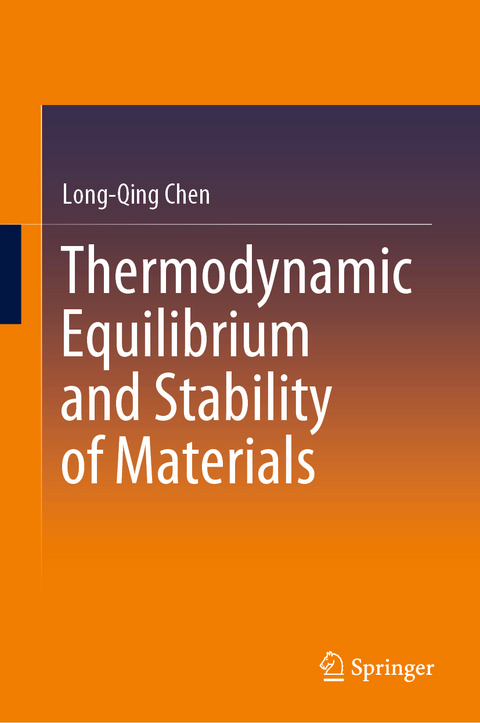
Thermodynamic Equilibrium and Stability of Materials
Springer Verlag, Singapore
978-981-13-8690-9 (ISBN)
The textbook employs a plain language to explain the thermodynamic concepts and quantities. It embraces the mathematical beauty and rigor of Gibbs thermodynamics through the fundamental equation of thermodynamics from which all thermodynamic properties of a material can be derived. However, a reader with basic first-year undergraduate calculus skills will be able to get through the book without difficulty. One unique feature of this textbook is the descriptions of the step-by-step procedures for computing all the thermodynamic properties from the fundamental equation of thermodynamics and all the thermodynamic energies from a set of common, experimentally measurable thermodynamic properties, supplemented with ample numerical examples.
Another unique feature of this textbook is its emphasis on the concept of chemical potential and its applications to phase equilibria in single component systems and binary solutions, chemical reaction equilibria, and lattice and electronic defects in crystals. The concept of chemical potential is introduced at the very beginning of the book together with temperature and pressure. It avoids or minimizes the use of terms such as molar Gibbs free energy, partial molar Gibbs free energy, or Gibbs potential because molar Gibbs free energy or partial molar Gibbs free energy is precisely the chemical potential of a material or a component. It is the chemical potential that determines the stability of chemical species, compounds, and phases and their tendency to chemically react to form new species, transform to new physical state, and migrate from one spatial location to another. Therefore, it is the chemical potential differences or gradients that driveessentially all materials processes of interest.
A reader after finishing reading the book is expected to not only achieve a high-level fundamental understanding of thermodynamics but also acquire the analytical skills of applying thermodynamics to determining materials equilibrium and driving forces for materials processes.
Long-Qing Chen received B.S., M.S. and Ph.D. degrees, all in materials science and engineering, from Zhejiang University, Stony Brook University, and the Massachusetts Institute of Technology, respectively. He has been teaching thermodynamics of materials and kinetics of materials at Penn State since 1992 and is currently the Donald W. Hamer Professor of Materials Science and Engineering, Professor of Engineering Science and Mechanics, and Professor of Mathematics. He has published over 600 papers in the area of thermodynamics, kinetics, and computational modeling of materials processes and microstructure evolution in structural alloys, functional ceramics, energy materials, and polymer-based composites. Prof. Chen is the Editor-in-Chief for npj Computational Materials published by Springer Nature. He is a fellow of several major professional materials societies including Materials Research Society (MRS), The Metals, Minerals and Materials (TMS) Society, the American Ceramic Society (ACerS), and American Society for Metals (ASM) International as well as a fellow of the American Physical Society (APS) and of American Association for the Advancement of Science (AAAS). He has received many awards for his research including the 2014 MRS Materials Theory Award, the Humboldt Prize, and a Guggenheim Fellowship.
Introduction and Definitions.- First and Second Laws of Thermodynamics.- Fundamental Equation of Thermodynamics.- Thermodynamic Properties.- Internal Energy.- Enthalpy.- Entropy.- Gibbs Free Energy.- Chemical Potential.- Thermodynamic Equilibrium and Stability Conditions.- Thermomechanical Equilibria: Phase Equilibria with Respect to Temperature and Pressure.- Chemical Equilibria: Thermodynamics of Chemical Species Mixing to Form Solutions.- Phase Equilibria in Binary Systems and Graphical Representations.- Chemical Reaction Equilibria and Graphical Representations.- Defect Equilibria: Chemical Potentials of Electronic and Atomic Defects.- Energy Conversions: Electrochemical energy conversion.
| Erscheinungsdatum | 29.12.2021 |
|---|---|
| Zusatzinfo | 7 Illustrations, color; 96 Illustrations, black and white; XIX, 455 p. 103 illus., 7 illus. in color. |
| Verlagsort | Singapore |
| Sprache | englisch |
| Maße | 155 x 235 mm |
| Themenwelt | Naturwissenschaften ► Chemie ► Physikalische Chemie |
| Naturwissenschaften ► Physik / Astronomie ► Thermodynamik | |
| Technik ► Maschinenbau | |
| Schlagworte | chemical potential • chemical reactions • Electrochemistry • energy conversion • Enthalpy • Entropy • free energy • Fundamental Equation of Thermodynamics • internal energy • Laws of Thermodymamics • Maxwell relations • Phase Equilibria • property relations • Reaction Equilibria • Thermodynamic properties • Thermodynamics of Materials • thermodynamics textbook |
| ISBN-10 | 981-13-8690-0 / 9811386900 |
| ISBN-13 | 978-981-13-8690-9 / 9789811386909 |
| Zustand | Neuware |
| Haben Sie eine Frage zum Produkt? |
aus dem Bereich


